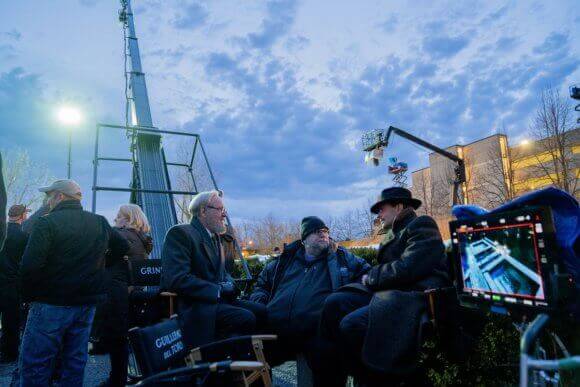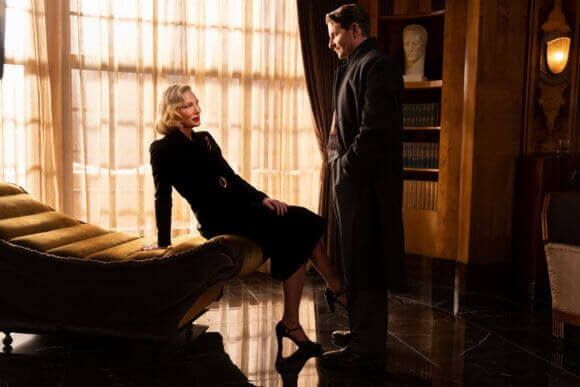
Although Nightmare Alley is the most grounded in reality film from Oscar-winner Guillermo del Toro, there’s still a monster at the heart of the story. Nightmare Alley follows Stanton Carlisle, a charismatic hustler whose charm and handsome exterior allow him to transition from carny sideshow to New York society. Bradley Cooper stars as Stan, the conman who sold his soul in pursuit of the American dream, and Toni Collette, Rooney Mara, and Cate Blanchett play the three women whose lives become entangled with Stan’s.
Searchlight Pictures recently hosted a special Critics Choice Association press conference in support of the film’s December 17, 2021 release. During the press conference, writer/director Guillermo del Toro discussed his lifetime love of film noir, Nightmare Alley‘s themes, his cast, and his approach to adapting William Lindsay Gresham’s 1947 for the screen.
When did your love of noir begin?
Guillermo del Toro: “If you knew my short films when I was a kid, I wanted to do just horror, fantasy, and noir. They were my first loves, and I did a whole noir little short in the provinces in Mexico about corrupt policemen and this and that. I was enamored, first of all, of the literature, of the writing. I loved James M. Cain, Donald Westlake…I loved all the Black Mask detective stories. Chandler, Cornell Woolrich, and the harder ones – James Hadley Chase and so forth. And all the way to the neo-noir that started in Europe.
I was in love with that because I think like horror it’s a genre that rips off the lid of the pretense of normalcy and it exposes very raw moral questions. It’s very much a parable genre, in a way, and it always attracts me that it reflects the time the movies were made in. You can see a post-World War II genre movie with Robert Mitchum and you get the sense of the time, the anxiety of the time. You then watch a post-Vietnam Elliott Gould in The Long Goodbye and it reflects that time. The Postman Always Rings Twice – the Bob Rafelson movie – reflects that time and so forth. I thought these are genres that are very sensitive to what’s going on in the world at that time.”
Nightmare Alley is about an ambitious man determined to create illusions for a larger audience. To what extent can you relate to Stan and your own drive and ambitions as an artist?
Guillermo del Toro: “You know, these are questions that are very real for me as a storyteller. I think that’s precisely what I have tried to be – cautious in my own life about understanding that. I’ve said it many, many times over the decades, I find the notion of success incredibly torturous. I find that as an artist I’ve clung to the definition of that success as f**king up in your own terms. That’s basically it. It’s not about how people appraise what you do but how you feel that you’re expressing what you are. And that took a while to figure out.
I find the American dream an incredible generator of nightmares. I think that’s something that was important also in terms of that the movie reflects a character that is two steps away from losing everything the whole movie because he’s absolutely made of lies. He’s not shielded by the truth about himself or others, so he’s always in danger. He’s fraught. I think you try to do that with what you do. You try to bring some form of truth to what you do and not think of career, for example, but think about just staying loyal to what you want to tell.
We are storytellers and Stanley’s a storyteller. And the fact is every question Stan has has to be a question I have asked myself, otherwise I can not co-write it with Kim Morgan. I would be coming from the outside.
I’m a little bit Molly, I’m a little bit Grindle, I’m a little bit the Major. (Laughing) I’m a lot of Pete. I’m very Pete-ish. So, you know, you have to understand them.”
Can you discuss your approach to the central characters?
Guillermo del Toro: “The movie’s constructed around the idea of people finding themselves and who they are, and the moment of revelation. It happens to Molly. It happens to Grindle. It happens to Pete…blah, blah, blah. And the beauty of it is there’s a rule in magic – I’m a terrible magician but I’m a student of magic – that says the audience thinks they can’t be fooled but want to be fooled. That’s the same with spiritualism.
Grindle built a garden and he’s ready to see her and then when it’s all fake, his world crumbles. That’s a beautiful thing because most of the characters in this movie they’re built for their endings, you know? The whole movie’s constructed for the last two minutes of Stan to go, ‘Oh, this is who I am.’”
The three strong female characters are each so different. What do they represent?
Guillermo del Toro: “To us, it was very important to have the symmetry of three women and three fathers for Stan. These three figures each illuminate this negative space that Stan is. Stan is somebody that…and it’s one of the reasons that I thought Bradley Cooper could pull it off because he looks like a movie star from the ‘30s and the ‘40s…and everybody projects onto Stan. […] Kim and I discussed this very detailed and she said, ‘We’re going to have the archetypes – the ingenue, the femme fatale, the earthy heart-of-gold humanistic character. I want the three to survive and in fact thrive after Stan.’ And they all see him in some way but they’re hoping he’s not that.
I think the beautiful thing with Molly and this was mapped – I don’t know how Rooney mapped it – but every time she would come into a scene she landed exactly in the moment Molly was. For me, I was just in admiration she landed in the moment Molly was. She was resisting Stan at the beginning, but she was not playing that she was resisting. […] It was really beautiful to see that.
I think the three forces end up with what I consider almost a superhero-sized figure, a mythical figure, which is Lilith – which is named Biblically by the author, William Lindsay Gresham. That’s how monumental she is. But we wanted to do archetypes that were actually real and they would survive and not be punished, not be doomed, by their relationships with Stan.”
In what way does this story full of fools and foolers resonate in today’s society?
Guillermo del Toro: “There are characters that mean for me different things. I think that the crucial moment we are in at an almost basic level truth and illusion or truth and lies are so dependent upon us being gullible and us being capable of being compassionate. We wanted to imbue the movie with the anxiety of this time, you know? We wanted not to make a movie about the period; we wanted to make it about now.
I think that essential moment we’re in in which we have to distinguish narrative truth and narrative lie with reality – it’s so important because what I think is very interesting for me about the character of Stan is he, in reality, there’s a happy ending in the middle of the movie. (spoilers redacted) […] And this was one of the main things I wanted to do in the movie, you cut to two years later and he’s unhappy. You cut and he’s unhappy. It’s a moment in which I believe that there is an emptiness in him and a need for more and more and more that I also find pertinent. All Stan wants is to be seen for what he is. The liberation in the movie comes in the last two minutes for him.
Grindle wants to be forgiven, which I think there’s also an urgency for us to be human and be capable of forgiveness and be capable of seeing each other. All those things are fraught, and the movie is permeated with that. These characters mean something to me. Hopefully, they reflect the time and so forth.”

Stan’s profession is all about noticing the details of people to inform his work. How has your relationship with including details evolved working on Nightmare Alley? Did you make a more conscious effort to fill the frame?
Guillermo del Toro: “Yes and no. Two things happened which is I’m 57 and every time I learn something new it’s a gift from the heavens because the worst thing you can do is, ‘This is what I do.’ So, at the same time when we come to everyone in the cast we came in with all the drawings and the paintings, and everything was cyphered. The circle was going to be framing Stan the whole time. It was seen through mirrors and reflecting this and that – three mirrors at the same time…blah, blah, blah.
Once he goes to the city everything is an alley. He abandons the color red when he leaves the carnival. The only four things in red in the city are Molly’s dress, Lilith’s lips, the Salvation Army, and blood. That’s it. The rest is I directed not to have any red. You can watch the movie as many times as you want. Oh…there’s one lightbulb in the elevator…sorry! But, yeah, we did all that.
And then what I learned which is gorgeous is then in a way…and Richard and I have made two movies together and there was for me an evolution. I started shooting everything complete. I didn’t cut; I didn’t do little pieces. Richard taught me something beautiful in The Shape of Water. (Laughing) Not only did he use my biography (of his character) to light the fire under his boiler room or something, but he said to me, ‘Look, let me try two or three things and see what comes out.’ He said, ‘Because if you tell me what you want from the beginning, it’s like ordering a fabric in a store. I’ll bring the fabric you want but if you let me try it, I’ll bring you the best fabric from every shelf in the store and we’ll choose together.’ And that was lesson number one.
And lesson number two in this movie is why should I cut? I know where I’m going to cut. I’ll use the crane like a witness. The camera is never high in this movie – almost never high. Almost all the time it has the point of view of a child and is always curious, like trying to look over shoulders. I shot characters from behind a lot, like the revelations came on the back of characters. You know, Stan, not looking at the camera. I started letting the actors take what was in them and I just watched them with the camera very curious trying to take a look and a new language evolved.
So, yes, there are all the normal things and the key to that is that they have not to be done for beauty but for story and character. The image of Lilith when you see her office is not only an alley, but it’s permeated by almost inkblot tests from a psychological test in the wood. Everything is pristine; everything is in order but there is a tension in it.”
* * * * * * * *
Nightmare Alley is rated R and opens in theaters on December 17, 2021.






